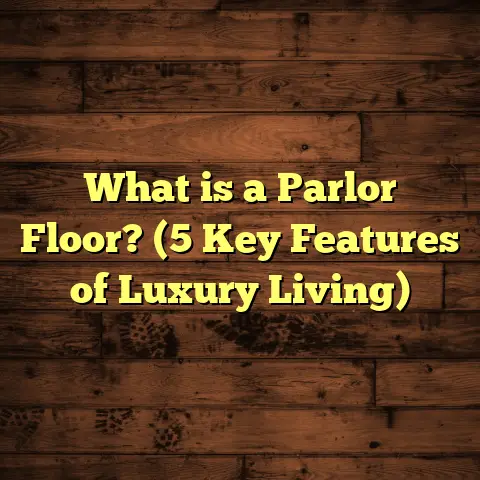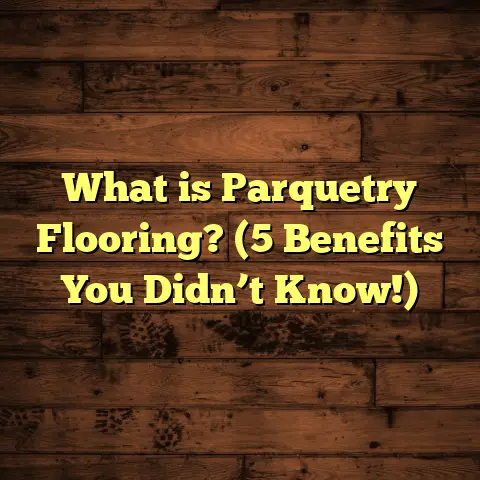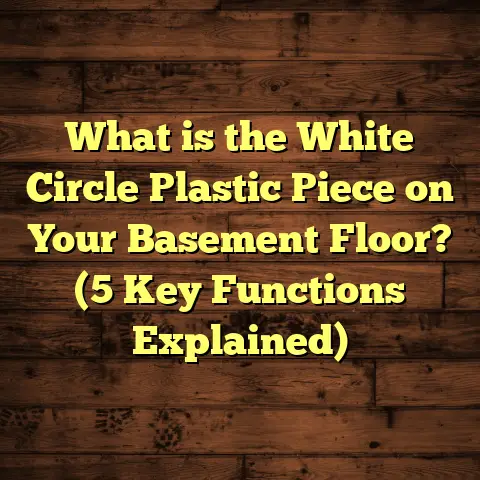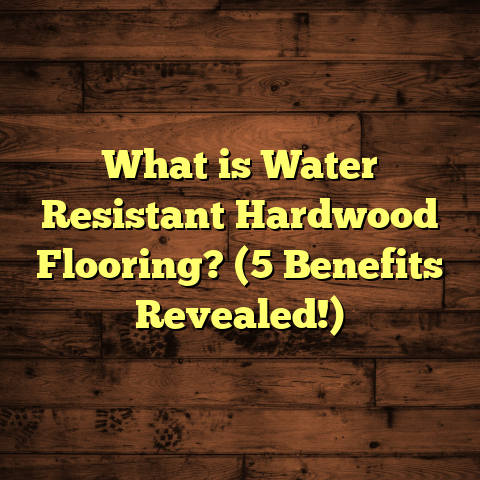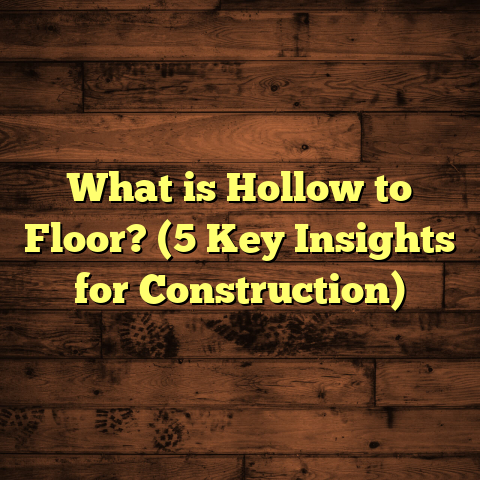What is the Average Cost of Epoxy Flooring in Las Vegas? (5 Factors to Consider)
Epoxy flooring has become a growing trend in Las Vegas, popping up in homes, offices, and commercial spaces alike. I’ve noticed this surge firsthand over the years of working as a flooring contractor here. More people are curious about what epoxy floors cost, how they perform in desert conditions, and whether it’s a smart investment for their properties. So, I thought I’d share everything I’ve learned after installing dozens of epoxy floors around Las Vegas — including costs, practical tips, and what to watch out for.
What is Epoxy Flooring?
Let’s start with the basics. What exactly is epoxy flooring?
Epoxy flooring is a type of coating made by mixing two main components: resin and hardener. When combined, they chemically react and form a rigid plastic material that bonds tightly to concrete surfaces. This creates a smooth, strong, glossy finish that can withstand heavy use.
I like to think of it as a protective shield for your floor that also looks sleek and clean. It’s widely used in industrial settings like factories and garages because it resists spills, stains, impact, and abrasion. But more homeowners in Las Vegas have caught on to its benefits for residential use — especially in garages, basements, patios, and even kitchens.
The process of applying epoxy flooring usually involves these steps:
- Surface preparation: The concrete must be cleaned thoroughly, removing grease, dirt, paint, or old sealers. Sometimes grinding or shot blasting is needed to roughen the surface so the epoxy sticks well.
- Repairing cracks: Any cracks or holes need to be patched before applying epoxy.
- Priming: A primer coat can improve adhesion.
- Applying epoxy coats: Multiple layers of epoxy resin are applied using rollers or squeegees.
- Optional additives: Decorative flakes or quartz can be broadcast on top for texture and design.
- Topcoat/sealant: A clear topcoat protects the epoxy and adds shine.
Once cured — which can take 24 to 72 hours depending on temperature — you get a seamless, durable floor that’s easy to clean and maintain.
Why Epoxy Floors Work Well in Las Vegas
Las Vegas’ desert climate presents some unique challenges and opportunities for flooring choices. Our hot summers can cause concrete slabs to expand and crack. Dust and sand constantly blow into homes and businesses. Plus, many properties see heavy foot traffic or vehicle use.
Epoxy floors shine in these conditions because:
- They’re resistant to UV rays when properly formulated.
- They don’t absorb dust or dirt easily — making cleaning simpler.
- They protect concrete from moisture and chemical damage.
- They add slip resistance when textured additives are used.
- They keep spaces looking modern and polished.
I’ve seen countless clients thrilled with how their epoxy floors stand up to the harsh Vegas environment while still looking great years later.
Average Cost of Epoxy Flooring in Las Vegas: What You Can Expect
One question I get asked all the time: How much does epoxy flooring cost in Las Vegas?
From my experience installing in different neighborhoods — Summerlin, Henderson, Downtown Vegas — prices vary based on several factors. But here’s a general breakdown based on square footage:
| Epoxy Flooring Type | Price Range (per sq.ft) | Description |
|---|---|---|
| Basic solid color coating | $3 – $5 | Simple single-color epoxy with minimal prep |
| Decorative flakes or quartz | $5 – $7 | Adds texture & grip by broadcasting flakes |
| Metallic epoxy finishes | $7 – $12 | Swirling metallic effects requiring skillful application |
| Industrial-grade or chemical-resistant | $8 – $15 | For heavy-duty commercial uses |
For example, a 1,200 square-foot garage in Summerlin with basic gray epoxy might cost around $4,800 to $6,000 including prep work. But if you want a metallic finish with flakes and anti-slip additive in a restaurant kitchen downtown? That same area could easily top $14,000 due to extra labor and materials.
Why Does Price Vary So Much?
The wide price range comes down to five main factors I’ve seen firsthand:
1. Floor Size and Shape
Larger areas typically cost less per square foot because contractors can work more efficiently with bigger spaces. Smaller or oddly shaped rooms take more time for edging and detailing.
A client in Henderson wanted epoxy for his 3-car garage (about 900 sq.ft). The job was straightforward and came out to about $4.50 per sq.ft.
Contrast that with another client whose 700 sq.ft basement had multiple pillars and stairs — prepping took extra time which pushed the price closer to $7 per sq.ft.
2. Surface Condition & Preparation Needs
If your floor has cracks, stains from oil or paint, or old coatings that need removal — expect to pay more for prep.
I remember a warehouse client near the Strip where the concrete was severely cracked and stained by chemicals. We had to grind down uneven areas and fill multiple cracks before applying epoxy. Prep alone added about $2 per sq.ft on that project.
Prep is the most critical step to avoid peeling later. Skipping it can mean wasted money when floors fail early.
3. Epoxy Material Quality & Type
Low-cost epoxies are fine for light residential use but wear out faster. Premium industrial epoxies have better UV resistance (important here), chemical resistance, and durability — but cost more upfront.
For example, UV-stable epoxies suitable for outdoor patios add roughly $1-$3 per sq.ft extra.
4. Design Complexity & Additives
Adding decorative flakes or quartz not only enhances grip but also adds visual appeal. Broadcast flake jobs require extra labor steps like spreading flakes evenly then sealing multiple layers.
Metallic finishes are an art form — you need skilled technicians who can pour and manipulate colors without streaks or bubbles. These jobs usually take longer and cost more.
5. Labor Costs & Contractor Experience
Labor rates vary by contractor skill level and demand in Las Vegas. Experienced pros charge more but deliver longer-lasting floors without defects.
I’ve seen labor quotes range from $2 up to $6 per sq.ft around town depending on complexity.
Timeframe: How Long Does Installation Take?
Most residential epoxy floors take between 2 to 4 days from prep to cure:
- Day 1: Surface prep & repairs
- Day 2: Primer & base coat application
- Day 3: Decorative flakes & topcoat
- Day 4 (optional): Additional sealing or touch-ups
Commercial floors may take longer depending on size and design complexity.
Weather matters too — extreme heat above 100°F can affect curing times and finish quality here in Las Vegas.
Real Data From My Projects Around Las Vegas
I want to share some real numbers from recent jobs so you get a clearer picture of costs:
| Location | Square Footage | Type of Epoxy | Cost per Sq.Ft | Total Cost | Notes |
|---|---|---|---|---|---|
| Summerlin Home Garage | 1,000 | Basic solid color | $4 | $4,000 | Smooth concrete; minimal cracks |
| Downtown Restaurant Kitchen | 1,500 | Metallic + anti-slip | $11 | $16,500 | Heavy prep; chemical-resistant epoxy |
| Henderson Warehouse | 2,500 | Industrial grade | $7 | $17,500 | Large open space; minor crack repairs |
| North Las Vegas Basement | 900 | Flake broadcast | $6 | $5,400 | Multiple pillars & stairs |
These examples show how price changes with floor condition and design preferences.
Case Study: Transforming a Garage Floor in Las Vegas
I’d like to tell you about a recent garage floor project I was involved with in Henderson near Lake Mead Parkway. The client wanted something durable yet stylish with quartz flakes for grip because he parks his motorcycle inside.
The garage was about 850 square feet but had some serious oil stains and cracks from years of use. Here’s what we did:
- Prep: We spent a full day grinding the surface to remove stains and roughen it up.
- Repairs: Filled cracks with epoxy fillers — took another half-day.
- Application: Applied two coats of high-quality epoxy resin mixed with quartz flakes broadcast on top.
- Sealant: Finished with a UV-resistant clear topcoat.
Total project cost came to around $7 per square foot or about $6,000 total.
The client was overjoyed because his garage went from dingy and stained to bright, clean, and slip-resistant. Plus, he said it feels cooler during summer nights — which surprised me until I realized how reflective epoxy surfaces can reduce heat absorption compared to bare concrete.
How Epoxy Flooring Compares With Other Popular Flooring Options
If you’re still weighing options for your garage or basement floor here in Las Vegas, how does epoxy stack up against others?
| Flooring Type | Average Cost (per sq.ft) | Durability | Maintenance | Best Use Case |
|---|---|---|---|---|
| Epoxy Flooring | $3 – $12 | Very high | Easy | Garages, basements, commercial |
| Polished Concrete | $3 – $8 | High | Moderate | Modern homes & commercial spaces |
| Vinyl Flooring | $2 – $7 | Moderate | Easy | Residential basements |
| Ceramic Tile | $5 – $15 | High | Moderate | Kitchens & bathrooms |
| Carpet | $2 – $6 | Low | High (vacuuming) | Bedrooms |
Epoxy floors win when durability and ease of cleaning are priorities. Unlike vinyl or carpet, they resist stains and heavy wear much better under harsher conditions like garages or workshops.
Maintaining Your Epoxy Floor: Tips From My Experience
To keep your epoxy floor looking great for years:
- Clean regularly with mild soap & water; avoid harsh chemicals.
- Use soft brooms or mops; avoid abrasive scrubbers.
- Place mats at entrances to reduce grit scratching.
- Fix chips or damage quickly with repair kits.
- Avoid dragging heavy furniture without padding underneath.
From what I’ve seen around Vegas homes—those who follow these simple steps keep their floors shiny for over a decade without needing costly recoats.
Frequently Asked Questions About Epoxy Flooring in Las Vegas
Q: Can I install epoxy flooring myself?
A: You can try DIY kits but prepping concrete properly is tough and mistakes can be costly. I recommend hiring pros who know local conditions well.
Q: How long before I can walk on my new floor?
A: Typically 24 hours but avoid heavy traffic for at least 72 hours to ensure full curing.
Q: Will epoxy yellow over time in the desert sun?
A: Standard epoxies may yellow if exposed directly outdoors without UV inhibitors. Use UV-stable formulations for patios or exterior areas here.
Q: What happens if my floor cracks after installation?
A: Hairline cracks may appear from concrete movement; small repairs can be done but significant cracking requires professional evaluation.
Q: Can I change the color later?
A: You’d need to sand off old epoxy before recoating which is labor-intensive but doable by pros.
Why Choosing Local Experienced Contractors Matters
When I started installing epoxy floors here years ago, I learned quickly that every city has its own quirks—from climate challenges to concrete mix types used during construction.
Las Vegas’ desert heat affects drying times and material behavior differently than cooler climates. Contractors familiar with these nuances deliver better results because they know when to adjust application techniques or choose specific products.
Always ask your installer about previous local projects they’ve completed. Check reviews specifically mentioning work done in Las Vegas neighborhoods similar to yours.
Wrapping Up: Is Epoxy Flooring Worth It in Las Vegas?
I hope by now you have a solid idea of what goes into the cost of epoxy flooring here in Las Vegas—and how factors like size, prep work, materials, design complexity, and labor shape the final price tag.
From my experience working on dozens of projects across the city: epoxy flooring offers excellent value for its durability and aesthetic benefits compared to alternatives like vinyl or carpet—especially given our climate challenges and dust issues.
If you want a long-lasting floor that looks professional while resisting stains and damage from vehicles or chemicals—I highly recommend considering epoxy as an option.
Got questions about your specific project? Feel free to ask—I’m always happy to share advice based on real work I’ve done around town!
